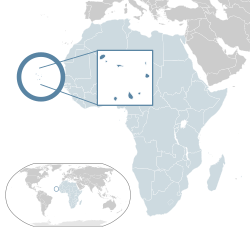
Cape Verde
Island nation in northwest Africa / From Wikipedia, the free encyclopedia
Dear Wikiwand AI, let's keep it short by simply answering these key questions:
Can you list the top facts and stats about Cape Verde?
Summarize this article for a 10 years old
Cape Verde (/ˈvɜːrd(i)/ ⓘ, VURD or VUR-dee) or Cabo Verde (/ˌkɑːboʊ ˈvɜːrdeɪ/ ⓘ, /ˌkæb-/ KA(H)B-oh VUR-day; Portuguese: [ˈkaβu ˈveɾðɨ]), officially the Republic of Cabo Verde, is an archipelago and island country in the central Atlantic Ocean, consisting of ten volcanic islands with a combined land area of about 4,033 square kilometres (1,557 sq mi).[9] These islands lie between 600 and 850 kilometres (320 and 460 nautical miles) west of Cap-Vert, the westernmost point of continental Africa. The Cape Verde islands form part of the Macaronesia ecoregion, along with the Azores, the Canary Islands, Madeira, and the Savage Isles.
Republic of Cabo Verde | |
|---|---|
Motto:
| |
| Anthem: Cântico da Liberdade (Portuguese) (English: "Chant of Freedom") | |
| Capital and largest city | Praia 14°54′59″N 23°30′34″W |
| Official languages | Portuguese[1] |
| Recognised national languages | Cape Verdean Creole[1] |
| Religion |
|
| Demonym(s) | Cape Verdean or Cabo Verdean[3] |
| Government | Unitary semi-presidential republic[4] |
| José Maria Neves | |
| Ulisses Correia e Silva | |
| Legislature | National Assembly |
| Independence from Portugal | |
• Granted | 5 July 1975 |
| Area | |
• Total | 4,033 km2 (1,557 sq mi) (166th) |
• Water (%) | negligible |
| Population | |
• 2021 census | 561,901[5] (172nd) |
• Density | 123.7/km2 (320.4/sq mi) (89th) |
| GDP (PPP) | 2022 estimate |
• Total | $4.413 billion |
• Per capita | $7,740[6] |
| GDP (nominal) | 2022 estimate |
• Total | $1.997 billion |
• Per capita | $3,502[6] |
| Gini (2015) | medium |
| HDI (2021) | medium · 128th |
| Currency | Cape Verdean escudo (CVE) |
| Time zone | UTC–1 (CVT) |
| Date format | dd/mm/yyyy |
| Driving side | right |
| Calling code | +238 |
| ISO 3166 code | CV |
| Internet TLD | .cv |
The Cape Verde archipelago was uninhabited until the 15th century, when Portuguese explorers discovered and colonized the islands, thus establishing the first European settlement in the tropics. Because the Cape Verde islands were conveniently located to play a role in the Atlantic slave trade, Cape Verde became economically prosperous during the 16th and 17th centuries, attracting merchants, privateers, and pirates. It declined economically in the 19th century after the suppression of the Atlantic slave trade, and many of its inhabitants emigrated during that period. However, Cape Verde gradually recovered economically by becoming an important commercial center and useful stopover point along major shipping routes. Cape Verde became independent in 1975.
Since the early 1990s, Cape Verde has been a stable representative democracy and has remained one of the most developed and democratic countries in Africa. Lacking natural resources, its developing economy is mostly service-oriented, with a growing focus on tourism and foreign investment. Its population of around 483,628 (as of the 2021 Census[update]) is mostly of African and a minor European heritage, and predominantly Roman Catholic, reflecting the legacy of Portuguese rule. A sizeable Cape Verdean diaspora community exists across the world, especially in the United States and Portugal, considerably outnumbering the inhabitants on the islands. Cape Verde is a member state of the African Union.
Cape Verde's official language is Portuguese.[10] It is the language of instruction and government. It is also used in newspapers, television, and radio. The recognized national language is Cape Verdean Creole, which is spoken by the vast majority of the population.
As of the 2021 census the most populated islands were Santiago, where the capital Praia is located (269,370), São Vicente (74,016), Santo Antão (36,632), Fogo (33,519) and Sal (33,347). The largest cities are Praia (137,868), Mindelo (69,013), Espargos (24,500) and Assomada (21,297).[11]


.svg/220px-Cape_Verde_(orthographic_projection).svg.png)
